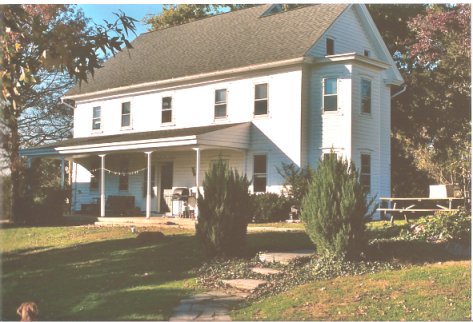![]() December 27, 2005
December 27, 2005
Tuesday

Although by the end of September I was wobbling on my focus to craft a literary novel set in contemporary times, I did not abandon fiction and writing altogether. Instead, I stepped back into the nineteenth century, and even farther.
In 1992, when I began writing again, my main impetus was to develop a story around the facts of a gravesite in Hain’s Cemetery in Wernersville, Pennsylvania. I took a master’s degree in American Studies, focusing on domestic life in 19th century Berks County. I learned a lot about writing, and research, and I came to love both the “plain” and the “fancy” Pennsylvania Germans. I wrote 6000 words of the novel, a manuscript that became the basis for my first admission to the Bread Loaf Writers’ Conference. And then I stopped, mostly because I let the tutor I had that year, who clearly had great disdain for both me and my work, steal my confidence in myself.
I haven’t abandoned my historical novel, but I did decide that learning to write fiction would be easier if I didn’t also have to learn to convey a 19th century sensibility in 19th century diction at the same time. But I still perk up when something related to Pennsylvania social history comes along.
In October, Deborah Larsen’s novel about a white girl kidnapped by Indians near Gettysburg in the 17th century was chosen as the community reading project by the two public library systems that serve the capital city. I’d read The White when it first came out, attending a reading by the author, whose first work of fiction was not published until she was 61 years old. (I have six years! I exclaimed then. Well, three of them are gone.) Among the many programs given in conjunction with promoting the reading of this book was one on the story behind Conrad Richter’s book The Light in the Forest, also about the kidnapping of a white child. I learned that the incident took place about six miles from my house, something I hadn’t known before even though I passed the historical marker noting it about three times a week.
Finally, in the end of October, I stepped into a world that seems to straddle the 19th century and the modern day. For the twentieth anniversary of the release of the movie Witness (about an Amish child who witnesses a murder in a Philadelphia train station and then must be protected from those who wish to silence him), Paramount Pictures developed a tour of the sites in Lancaster County where the movie was filmed.
The farmhouse seen above is the actual house where the filming took place. It dates from the early 19th century, and was not owned by an Amish family in 1985. It is now, however, and they made the summer kitchen (where most of the scenes were set), the barn, and the property available to tourists. So I did the very touristy thing, going to the Witness exhibit (“This is the actual hat Kelly McGillis wore to keep the sun off her face!” “Here’s a picture of Harrison Ford showing the extras how to hold a hammer!”) at the museum downtown and then riding on a bus for three hours through the beautiful rolling farmland of southern Lancaster County. I bought sweet potatoes and pepper jelly from the Amish woman who now lives in the house (along with her husband and four children under eight, with another due to be born in February).
And when I got home I pulled out my Katherine Project crate, reviewed it, and decided that all is not really lost.
To be included on the notify list, e-mail me:
margaretdeangelis [at] gmail [dot] com (replace the brackets with @ and a period)